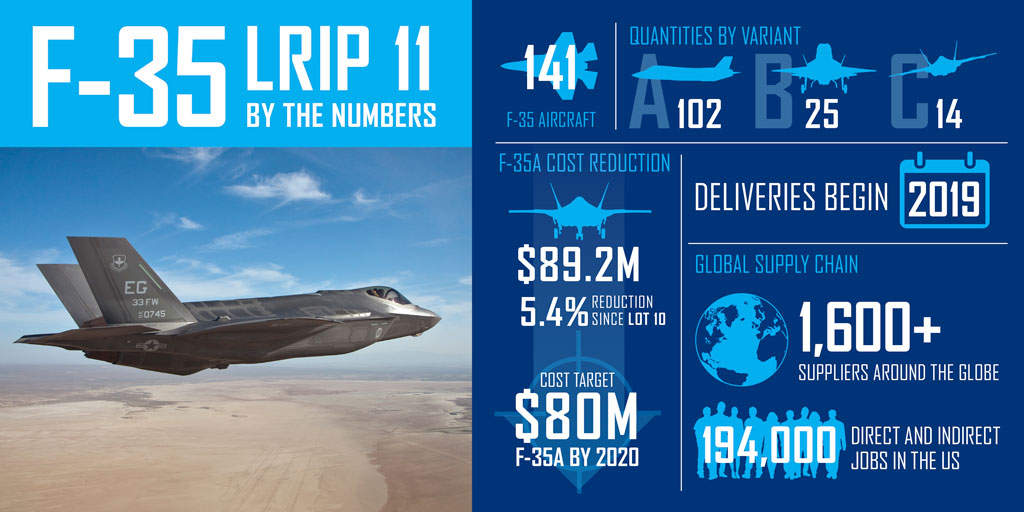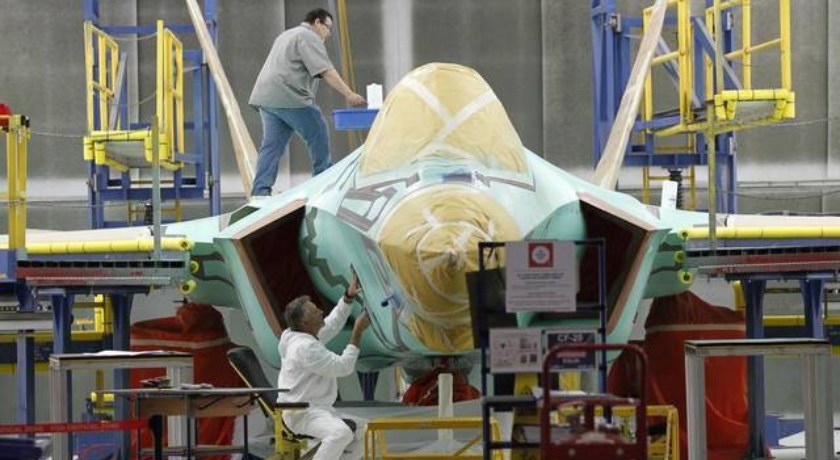The US Department of Defense and Lockheed Martin have finalised an US$11.5 billion contract for the production and delivery of 141 F-35 aircraft at the lowest per aircraft price in program history.
To continue reading the rest of this article, please log in.
Create free account to get unlimited news articles and more!
For the 11th consecutive year, the cost of an F-35A was lowered. The F-35A unit price, including aircraft, engine and fee, is US$89.2 million. This represents a 5.4 per cent reduction from the US$94.3 million it cost for an F-35A in low-rate initial production Lot 10 (LRIP 10).
In LRIP 11, the F-35B unit cost was lowered to US$115.5 million. This represents a 5.7 per cent reduction from the US$122.4 million it cost for the short-takeoff and landing variant in LRIP 10.
The F-35C unit cost was lowered to US$107.7 million. This represents an 11.1 per cent reduction from the US$121.2 million it cost for the carrier variant in LRIP 10.
The LRIP 11 agreement funds 91 aircraft for the US services, 28 for F-35 international partners and 22 for F-35 foreign military sales customers. Deliveries will begin in 2019.
Vice Admiral Mat Winter, F-35 Program Executive Officer, said, "We are delivering on our commitment to get the best price for taxpayers and warfighters. This agreement for the next lot of F-35s represents a fair deal for the US government, our international partnership and industry. We remain focused on aggressively reducing F-35 cost and delivering best value."

With stealth technology, supersonic speed, powerful sensors, large weapons capacity and global deployment, the F-35 is the most advanced fighter aircraft ever built, enabling women and men in uniform to execute their mission and return home safely. More than a fighter jet, the F-35's ability to collect, analyse and share data is a powerful force multiplier that enhances all airborne, surface and ground-based assets in the battlespace.
"This agreement marks a significant step forward for the F-35 program as we continue to increase production, reduce costs and deliver transformational capabilities to our men and women in uniform. As production ramps up, and we implement additional cost savings initiatives, we are on track to reduce the cost of the F-35A to US$80 million by 2020, which is equal to or less than legacy aircraft, while providing a major leap in capability," said Greg Ulmer, Lockheed Martin F-35 vice president and general manager.
The latest contract is a demonstration of the program’s progress and maturity, as industry and the government now set their sights on future acquisition approaches for the next three production lots to further reduce costs.
Director of F-35 international business development Steve Over said, “We will deliver 91 aircraft this year, that’s a total world-wide delivery and Australia received it’s first two aircraft in 2014, it is now up to eight aircraft and will receive an additional eight next year and then we ramp to fifteen planes each year in Lots 13, 14 and 15.”
With more than 320 aircraft operating from 15 bases around the globe – the F-35 is playing a critical role in today's global security environment. More than 680 pilots and 6,200 maintainers have been trained and the F-35 fleet has surpassed more than 155,000 cumulative flight hours. The F-35 weapons system reliability continues to improve through a combination of hardware and software improvements.
“The cost efficiencies are really driven by two things, learning, meaning we learn how to build their planes more efficiently, we are constantly tweaking our manufacturing processes to make them more efficient and to hone things. The other thing is scale, economic order quantity and the F-35 program is really ramping up into full rate production right now, so last year we delivered sixty-six aircraft, this year we will deliver 91, in 2019 we will deliver 131 and by 2020 we will be delivering in excess of 150 aircraft per year. That scale means we’re able to go negotiate with our supply chain to get the best prices,” Over said.
In addition to advanced capability, the F-35 provides economic stability to the US and allied nations by creating jobs, commerce and security, and contributing to the global trade balance. The F-35 is built by thousands of men and women in America and around the world. With more than 1,500 suppliers in 46 states and Puerto Rico, the F-35 program supports more than 194,000 direct and indirect jobs in the US alone. The program also includes more than 100 international suppliers, creating or sustaining thousands of international jobs.
Australia is spending about $17 billion to buy 72 fighters of the F-35A variant, with the aircraft due to reach IOC by December 2020. Australia’s first six F-35As are currently operating at the international Pilot Training Centre at Luke Air Force Base in Arizona, with four more aircraft expected to be delivered by the end of this year.
Two of Australia’s F-35A aircraft are scheduled to arrive for permanent basing at RAAF Base Williamtown near Newcastle in December this year.

 Login
Login







